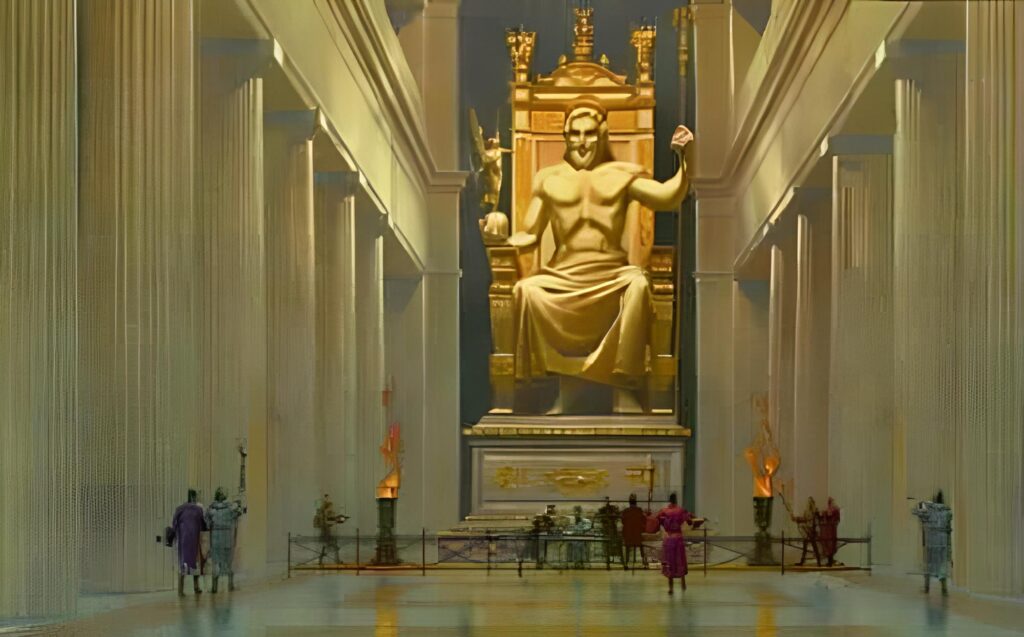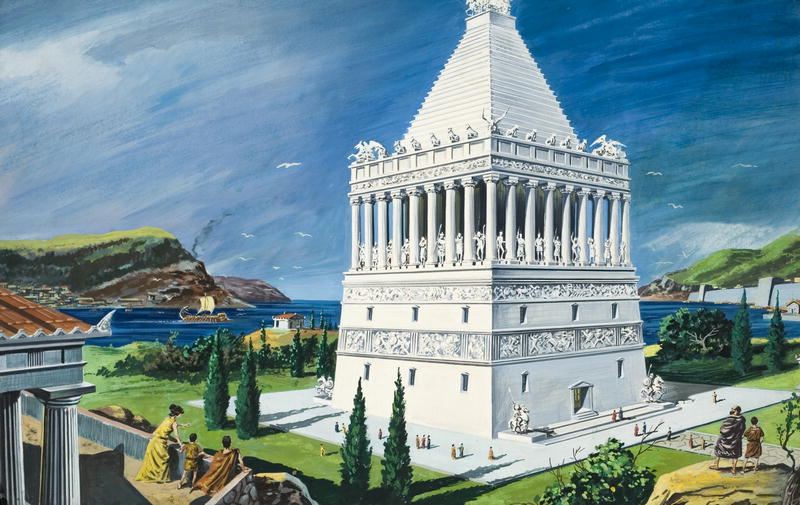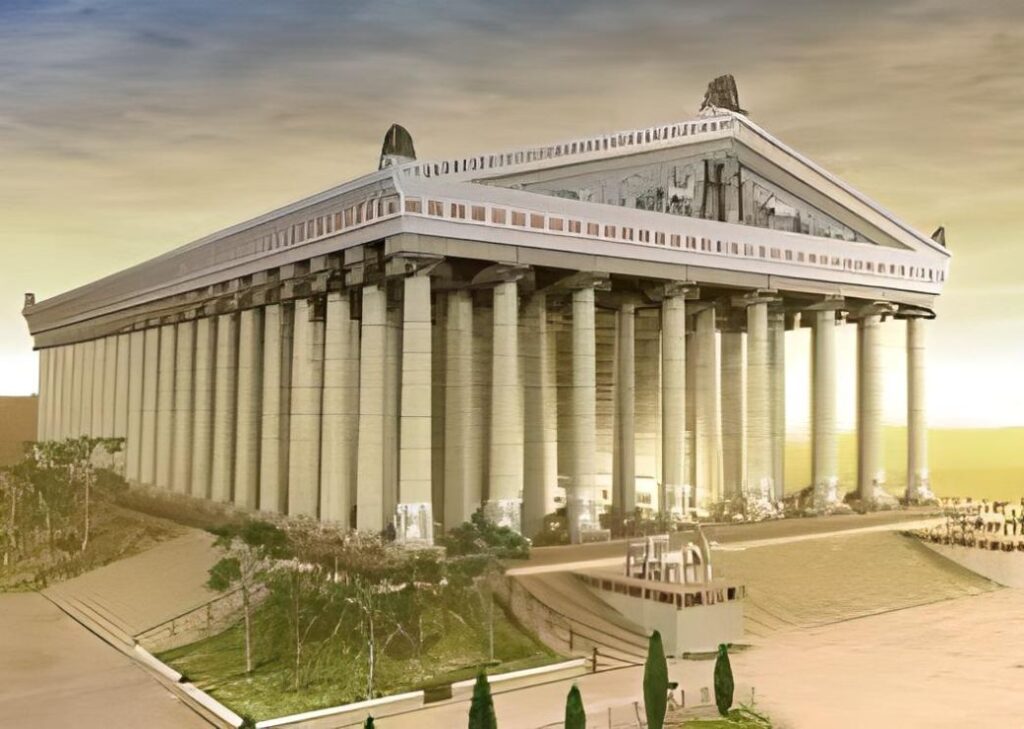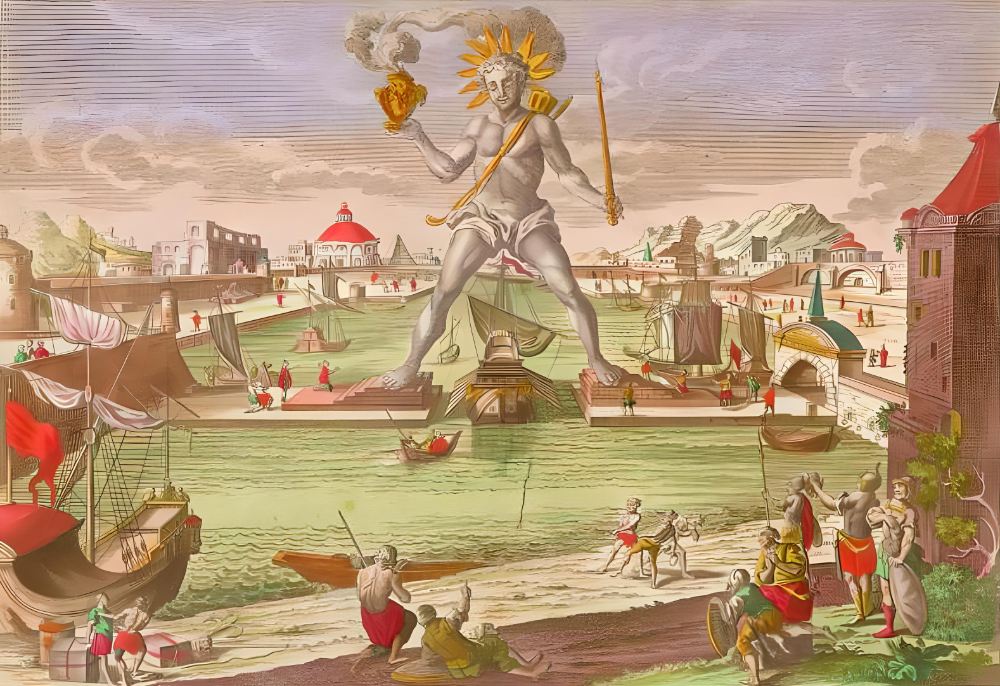The Ancient Greeks were ardent admirers of art and indefatigable explorers. As a result, they compiled a list of the Seven Wonders of the Ancient World. These monuments symbolized humanity’s foundational principles as well as its creative aspirations. These are the Mausoleum of Halicarnassus in Turkey, the Lighthouse of Alexandria, the Pyramid of Khufu in Giza, which is the only one that is still visible today, the Temple of Artemis in Ephesus, the Hanging Gardens of Babylon, the Colossus of Rhodes, and the Statue of Zeus in Olympia. It is still unknown how this list was compiled in the third or second century BC, or who wrote it.
- The Origin of the Seven Wonders and Their Symbolic Significance
- They Weren’t Originally “Wonders”
- The Great Pyramid of Giza
- The Hanging Gardens of Babylon
- The Statue of Zeus at Olympia
- The Mausoleum at Halicarnassus
- The Temple of Artemis
- The Colossus of Rhodes
- The Lighthouse of Alexandria
- Why Are None of the Seven Wonders of the Ancient World in Rome?
The Origin of the Seven Wonders and Their Symbolic Significance

The history of the list that is comprised of the seven wonders of the world is obscure and difficult to reconstruct. The list that is attributed to Philo of Byzantium is a later collection of material from earlier sources. Regarding this author, we have no information whatsoever. In addition to that, he does not make any reference to the lighthouse in Alexandria. However, it is vital to understand the lighthouse of Alexandria as it provides a limited date for the list. The Seven Wonders of the World only retain seven monuments because the ancient Greeks were probably influenced by the Pythagorean circles and by their love for numbers and lists. Today’s historians think that the list was most likely compiled in literary circles in Alexandria. Callimachus of Cyrene is often said to have made the list of the seven ancient wonders, but this doesn’t prove anything.
There is no doubt that throughout the time of the Romans, this list was a common source of information. At the time of the opening of the Colosseum in Rome in the year 80 A.D., the poet Martial described it as one of the many monuments that aspired to compete with the famous Seven Wonders. The elegiac poet Propertius believed that his verses were more indestructible than the pyramids, the Mausoleum, or the temple of Zeus at Olympia. A short time later, the treatises started to discuss the superiority of each monument, including the ones from Philo of Byzantium, which date back to the 3rd century BC, as well as others that date back to the 6th century AD and were written by Gregory of Tours, and Bede the Venerable (7th century). They served as a source of inspiration for painters throughout the Renaissance.
Similar to the seven sages of ancient Greece, the seven hills of Rome in paganic antiquity, and the seven deadly sins in Christianity, the symbolism of the Seven Wonders starts with the number seven. At first glance, the list may appear to be disjointed, with two statues dedicated to worship (one of the sun god Helios in Rhodes and one of Zeus in Olympia), two royal tombs (the pyramid of Cheops and the mausoleum of Halicarnassus), gardens (those of Babylon), a watchtower (the lighthouse of Alexandria), and a temple (the Artemisia in Ephesus). However, these are all examples of ancient structures that have been deemed worthy of preservation.
But what all of these structures have in common is that they have left an indelible mark on the collective imagination. Some of these structures have been so influential that they have given rise to words that have entered common usage: “colossal” refers to any monument that has huge proportions, such as the Colossus of Rhodes; “mausoleum” refers to the luxurious tombs of great personalities, in honor of the one that King Mausolus of Caria constructed at Halicarnassus in modern-day Turkey, or the “lighthouse” that has coined the term since the first one appeared on the Egyptian island of Pharos.
They Weren’t Originally “Wonders”
While making the list, the word “wonder” was not the term that was initially employed; rather, they were just monuments considered worthy of being seen. It wasn’t until much later that the concept of wonder came into use. It is comparable to a pamphlet geared towards tourists. The Great Pyramid of Giza is the only one of these landmarks that have been discovered by modern archaeologists. This marvel is exempt from voting since the New 7 Wonders of the World has bestowed upon it the title of “honorary status”.
The majority of the marvels provide challenges for historians since they are not widely understood (either in terms of their appearance or the techniques that were used to create them): the Hanging Gardens and the Colossus of Rhodes are still, to a significant degree, mysteries.
The Great Pyramid of Giza

There is a plethora of information, theories, and speculation about it. The Great Pyramid of Cheops at Giza is the oldest of the seven wonders of the world. The name Cheops is a Hellenization of Khufu, and the pyramid is more commonly referred to as the Great Pyramid of Giza today. It was constructed more than 4,500 years ago. It is not the oldest of the pyramids, but it may be the one with the most completed construction. For many centuries, the pyramid stood as one of the tallest structures anywhere on the globe, thanks to its height of 480 feet (146.5 meters). Even though the pyramid was probably built to be Pharaoh Kheops’ tomb, we were never able to find his remains.
This issue has piqued the interest of scholars from a wide variety of fields, and it is only one of the many challenges that the building of such a monument presents. The pyramid is shrouded in mystery, and the fact that it has three burial rooms contributes to this impression. This historic landmark is preserved in a state that is satisfactory to our eyes. Al-Ma’mun dug up the pyramid in the year 832 and it continues to fascinate people today.
But Vivant Denon’s scientific expedition during General Bonaparte’s Egyptian campaign and the famous Battle of the Pyramids on July 21, 1798, was the main thing that made the French more interested in this wonder and Egyptology.
The Hanging Gardens of Babylon

The gardens are one of the Seven Wonders of the World that very few people are familiar with. These gardens, which were constructed in the 6th century BC under the reign of Nebuchadnezzar II, are a symbol of the allure that Babylon exerted on humanity throughout history. Other notable structures inside the city include the walls, the Gate of Ishtar, and the Tower of Babel. All of these landmarks contributed to the city’s rise to prominence.
The gardens are not unique to Babylon; for instance, Nineveh had opulent gardens as well (some have even thought that the Hanging Gardens were not in Babylon but this city). The enormous size of the gardens of Babylon is primarily responsible for its widespread popularity. There is a lot of uncertainty around the history of the monument, and we do not know what happened to these gardens or why they were destroyed.
The Statue of Zeus at Olympia

One of the most well-known sculptures from ancient times is this incredible work of art made of gold and ivory. The piece, which dates back to the 5th century BC and was created by Phidias, was eventually placed in the temple of Zeus at Olympia. Before the construction of the Statue of Athena Parthenos at the Parthenon, Phidias had already created a chryselephantine statue that became highly well-known in antiquity. He completed his career with the statue of Olympia. We can get a very good idea of what the Statue of Zeus looked like by looking at different sources, especially coins, and the readings of the time it was made.
The statue would have been the most magnificent ever created in Greece: it was 65 feet (20 meters) high. Zeus is shown as a seated figure on his throne, clutching in his right hand what seems to be the god of Victory or Nike, and in his left hand what appears to be a scepter topped with an eagle. He sports a victory wreath made of branches on his head, much like the competitors who took first place in the Olympic Games. The use of gold and ivory is a reference to aesthetic concerns that were highly popular in ancient times. Ivory highlights the radiance of the God’s skin, while gold emphasizes his exquisite clothing and accessories. Throughout all of antiquity, the statue was held in high esteem.
In the year 380, when Emperor Theodosius outlawed pagan practices, the monument was not desecrated in any way. In the 5th century, it was moved to Constantinople, where it remains to this day. On the other hand, a fire in the year 475 put an end to it.
The Mausoleum at Halicarnassus

The tomb of the satrap, or King Mausolus of Caria, which was located in Halicarnassus, which is now known as Bodrum, Turkey, astonished contemporary observers. The roughly 148-foot-tall (45-meter) monument was first constructed by Mausolus during his lifetime, and then, after he died in 353 BC it was finished by his sister and wife Artemisia II. The friezes and figures that were used to decorate the monument were of the highest quality and stood up to 10 feet (3 meters) tall.
The Mausoleum of Halicarnassus gives an architectural synthesis of the world of the Eastern Mediterranean before the conquests of Alexander the Great. In a sense, it is a synthesis of the aesthetic canons of Greece, Asia Minor, and Egypt.
Because of its size and level of decoration, it became known as a mausoleum, which later became a generic term for any grandiose burial. Following it, there was an increase in the number of mausoleums. Such as the Mausoleum of Augustus or the Mausoleum of Hadrian in Rome, both of which are now occupied by the Castel Sant’Angelo. Up until the 13th century, the tomb maintained its upright position. The land in question was turned into a quarry to build Saint Peter’s Castle. Charles T. Newton, in the 19th century, was the one who made the subsequent discovery of the Mausoleum at Halicarnassus. Several pieces were found at the site that shows how beautiful the tomb of Mausolus must have been back in ancient times.
The Temple of Artemis

In the year 334 BC, Alexander the Great admired this temple while it was still being constructed. The Artemision, also known as the Temple of Artemis, is located at Ephesus and has dimensions of 377 ft (115 m) in length, 180 ft (55 m) in width, and 62 ft (19 m) in height. This temple was burned down in 356 and had to be rebuilt. It is dedicated to the Greek goddess who is thought to protect the city.
Why is it that this temple is considered one of the seven wonders of the world? Its great size and elaborate decorating led to this honor. The world-famous statue of Artemis of Ephesus may be seen within the temple. It is an Artemis of fertility that was worshipped at this location, and the popularity of the statue is directly linked to its polymastia, which translates to “many breasts.”
There are copies of this statue that can be viewed in various museums today to demonstrate what the original looked like. The most impressive of these copies is the one that is still maintained and can be seen at the museum in Naples. Despite this, the temple of Artemis was demolished much later, towards the tail end of the ancient world, and for mysterious reasons. Archaeological data, on the other hand, make it possible for us to have a concept that is rather close to the actual look of the monument. The British Museum is home to several carved columns that were discovered during the excavations.
The Colossus of Rhodes

It is the marvel that has been seen by almost all people for a considerable amount of time. After being constructed at the beginning of the third century BC, the colossus was destroyed by an earthquake in 227–226, which was a little more than fifty years after it was first built. The colossus that was supposed to depict the deity Helios was 13 feet (34 meters) tall. This statue is responsible for altering the definition of the term “colossus”, which was originally used to refer to a simple statue but has since come to imply a colossal sculpture. The worship of Helios was significant on the island due to the mythology that Helios was the one who pulled the island of Rhodes up out of the water. The monument was placed near the port’s primary access point. The colossus that is shown spanning the port in the fictitious images is a product of inaccurate knowledge that was prevalent throughout the 14th century.
To this day, it is not quite clear where exactly the colossus is situated. The placement of the Colossus of Rhodes on the list of the seven wonders of the world may largely be attributed to the fact that the structure is a magnificent example of Hellenistic architecture and artistic achievement. As a result of the colossus falling to the ground, the remnants of the statue were protected from being looted, and tourists like Pliny the Elder were able to see them. It wasn’t until the year 654 AD that the very last remnants were removed from the site for good.
The Colossus of Nero is a successor of the Colossus of Rhodes, much as the Statue of Liberty is a successor of the Colossus of Rhodes in our day. However, this statue had significant posterity.
The Lighthouse of Alexandria

People are still captivated by this well-known lighthouse, which has been featured in a great number of cartoons and films. The Lighthouse of Alexandria had a height of 422 feet (135 meters) and served as a navigational aid for mariners. It was most likely situated on the location of the existing Qaitbay fort. The building of this monument may be traced back to around 290 or 280 BC. When approaching the Ptolemaic capital from the sea, the monument was the first thing that could be seen on the shore.
Ptolemy I had the idea for the lighthouse at Alexandria, but Ptolemy II was the one who built it. The lighthouse was intended to be a symbol of the grandeur and splendor of the city. The name of the lighthouse derives from the island of Pharos, which is where the monument was first constructed. It wasn’t until much later that all of the structures of this kind were given the name “lighthouse” to describe them.
Today, the name of the archaeologist Jean-Yves Empereur is associated with this landmark. Empereur led underwater excavations around the Qaitbay fort, and during those excavations, he discovered, among other things, a statue of Ptolemy that was intended to be placed at the entrance of the lighthouse. The monument persisted through antiquity and did not vanish until the 15th century when it was destroyed by an earthquake. Even now, the lighthouse serves as the unofficial symbol of the city that Alexander the Great established.
Why Are None of the Seven Wonders of the Ancient World in Rome?
Greece is the birthplace of all seven of the world’s wonders. Herodotus, a renowned traveler who is often regarded as the father of history, focused the opening chapters of his book, Histories, on the marvels that might be found in Babylon and Egypt around the 5th century BC. Some structures such as the pyramids had already existed for one thousand five hundred years when he contemplated them. Their imposing proportions and magnificent beauty capture the attention of the historian’s eye and spark the imagination of the people who read his work.
However, the Greeks contributed to the grandeur of the early monuments, the technical mastery of the details, and the refinement of their creations, with examples like the gold and ivory chryselephantine statue of Zeus at Olympia. This enabled them to compete with the great Eastern civilizations of the past.
As a result, the Seven Wonders of the Ancient World have continued to captivate people for many years. The memory of these monuments has been brought back to life because of the various descriptions and pictures that have been created, many of which are fantastical. These monuments, on the other hand, are a celebration of the genius that is possessed by man. They are also a reflection of the dominance that the Greeks had over the rest of the globe throughout the Hellenistic era. Their world is based on the Eastern Mediterranean, so it does not include Rome or Carthage since those civilizations had not yet reached their zenith of dominance. If it had been done a few centuries later, when the Roman Empire was at its height, the list of the Seven Wonders of the World would have been completely different.
Bibliography:
- Peter Clayton and Martin J. Price, The Seven Wonders of the Ancient World (1990)
- Stephanie Dalley, The Mystery of the Hanging Garden of Babylon: an elusive World wonder traced (2013)
- Panorama with the Abduction of Helen Amidst the Wonders of the Ancient World


